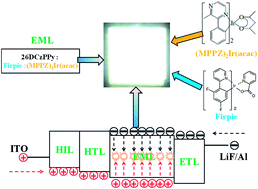Simultaneous achievement of low efficiency roll-off and stable color in highly efficient single-emitting-layer phosphorescent white organic light-emitting diodes
Abstract
A highly efficient single-emitting-layer white organic light-emitting diode with low efficiency roll-off and great color-stability has been fabricated and characterized. The resulting device achieves a forward-viewing current efficiency of 45.2 cd A−1 and a power efficiency of 37.1 lm W−1 at a luminance of 100 cd m−2. Even at 1000 cd m−2, a current efficiency of 43.6 cd A−1 and a power efficiency of 31.3 lm W−1 can be obtained, indicating that the device exhibits low efficiency roll-off. In addition, only a slight color-shift Δ ≤ (0.025, 0.006) can be observed during a large range of luminance, revealing that the device shows stable color. It is found that these superior properties originate from the introduction of multifunctional dopants as well as the bipolar host. Moreover, it is demonstrated that the dopants at low concentrations have almost no influence on the electrical properties when negligible energy barriers exist between the dopants and charge transport layers.


 Please wait while we load your content...
Please wait while we load your content...